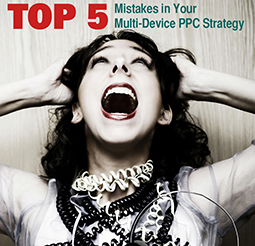Avoid these 5 mistakes to make your mobile marketing more effective

May 13, 2014: Failing to tailor content to the mobile user can lead to abandoned shopping carts and missed opportunities for conversions. Unfortunately, many web marketers — including e-commerce merchants — don’t make mobile usabilitity a priority.
Here are 5 of the most common mistakes web site owners make with when dealing with multiple devices, and how you can fix them.
Mistake 1: Using only desktop pages. We wish that this problem wasn’t as distressingly common as it is, but far too many website owners don’t want to bother with the added time and expense of developing either an adaptive design for their web pages or a separate mobile-optimized site. This is a huge mistake – according to a recent Google survey, 72% of users want mobile friendly sites. According to the survey, 67% of buyers who stay longer on mobile-optimized sites are more likely to convert. Retailers and other website owners are literally throwing away conversions — so don’t make this mistake.
Mistake 2: Not being careful with PPC ad copy. Copywriting for PPC is tricky business, because advertisers are restricted to two descriptions of 70 characters apiece. Advertisers should constantly test and vary copy, in keeping with brand guidelines. “Test, test, and test again” is the operative mantra here.
Mistake 3: Not paying attention to attribution and tracking. To be fair, this is a thorny issue, as the multiple device journey can be confusing for marketers to track accurately. Google, however, has made available cross device tracking in Universal Analytics. While not as easy to track as a traditional desktop conversion, the association of a user ID as specified in Universal Analytics can enable the construction of unique customer profiles. The drawback of this approach is that websites that primarily convert from one-time visits and new traffic will be at a disadvantage. Still, the effort spent in identifying unique customers across device is worth it, especially in terms of determining lifetime customer value.
Mistake 4: Not practicing good mobile SEO. Tighten up load times for your mobile pages, make use of click-to-call, store locators, and so on. Things which reduce load time and increase page performance are more likely to increase conversions and ROI.
Mistake 5: Not keeping content and promotions up to date across all pages. This problem can be tedious to solve, especially on complicated e-commerce websites, but all offers, sales and other promotions need to be kept up to date across sites. Promotions that lead mobile users to outdated or incorrect landing pages can result in frustration and abandonment.
The saga of how to handle multiple devices in PPC is ongoing, and we at Didit will keep you up to date. What other issues have you encountered? Contact us.
- 10 Mistakes to Avoid When Using QR Codes for Marketing - September 20, 2023
- Kevin Lee on How AI Changes the SEO Landscape - August 31, 2023
- The Power of Compound Marketing: Kevin Lee Presents @ 1MediaWorld 2023 Global Conference - March 7, 2023
